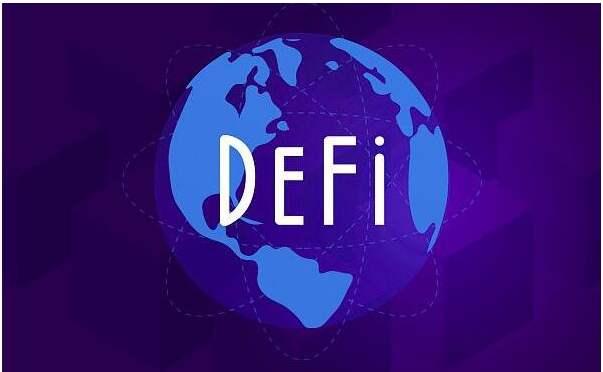Mirror has brought a revolution in content creation and the dawn of the Web 3 era
This article was published on ChainNews by LeftOfCenter.
We are seriously looking for blockchain and cryptocurrency native products that have the potential to "break out."
"Seriously" means that when we talk about "breaking out," we do not mean, as many people understand, letting blockchain or cryptocurrency topics appear in traditional or so-called "mainstream" media to create a strange sense of presence—usually, this sense of presence is more about satisfying the public's curiosity, which is a humble mindset and the effect is often fleeting. True "breaking out" should subtly yet powerfully capture ordinary users (individuals or businesses), change their habits, and thus achieve a paradigm shift.

For this reason, we have introduced NBA Top Shot, which disrupts the star card market, and have reported on Centrifuge, which uses DeFi to liberate the liquidity issues of asset flows in the supply chain finance sector in the real world. Recently, we are excited about a content publishing product created by former a16z crypto partner Denis Nazarov, called "Mirror.xyz" (shortened to Mirror).
Let’s keep it a mystery for now and not talk about Mirror. To better understand the Mirror product, let’s start with an internet product that is not far in the past but has already been forgotten by most Chinese readers.
I believe some may still remember Apple4us. This was a website born during the flourishing era of Web 2.0, consisting of a group blog made up of active internet figures from various fields, focusing on everything related to Apple Inc., industrial design, products, technology, and the lifestyle of young people.
Apple4us was initially initiated by Zhang Liang, an investor from Zhihu, with members including software engineers, product designers, mathematicians, fashion industry figures, and many entrepreneurs. Contributors included science fiction writer Fei Er, Zhihu founder Zhou Yuan, Zhihu co-founder Huang Jixin, IPN Network founder Li Ruyi, and NOMO founder Feizhu, among others.
The articles produced by this group blog had very high quality and influenced many people. Even today, many people are nostalgic about it, and it is also because of it that the later Q&A website Zhihu came into existence.
The reason for this, as summarized by Zhihu founder Zhou Yuan, is: "Apple4us did not determine topics and write articles like an editorial department; they were just answering questions. We had a discussion group where we would throw in questions we wanted to know every day. Why is the accuracy of the iPhone's virtual keyboard so high? How to evaluate the creativity of Apple's advertising TVC? What should the future of reading look like? For a journalist, figuring all this out requires a lot of time interviewing many people, but when you connect people with similar interests from different professional fields, they can almost immediately provide useful and helpful answers from their respective professional perspectives."
To summarize Zhou Yuan's point: compared to professional media, the reason Apple4us could produce higher quality and more influential articles lies in the creators' greater awareness of questions. Moreover, a key point is that the group blog's organizational form is more loose, not considering professional backgrounds, but connecting a group of like-minded individuals from different professional fields, allowing them to almost immediately provide useful and helpful answers from their respective professional perspectives.
However, Apple4us has long ceased to update, with the latest content on the site remaining from January 2018, sealed forever by the last maintainer Li Ruyi as "The Early 21st Century Chinese Science and Technology History."

This loose organizational form allowed Apple4us to produce high-quality articles, but it could not be sustained for long, primarily due to lack of commercial monetization ability, making it impossible to sustain the livelihoods of these original authors. This is why Zhou Yuan later started his entrepreneurial journey to create the capital-favored vertical Q&A website Zhihu.
Perhaps readers born in the 90s have never read articles from Apple4us and have no interest in this piece of internet history. However, revisiting the old stories of Apple4us can make the existing problems of today's internet clearer: the balance between content quality and livelihood is unachievable. This has been a long-standing dilemma.
Fortunately, today we have blockchain, ownership economy, and various emerging Web 3 applications that can solve such problems.
This is the grand ambition of the online content publishing platform Mirror, which attempts to redefine online content publishing by combining NFTs and ownership economy, potentially leading to revolutionary impacts on online content creation and direct breakout growth.
The creator of Mirror, Denis Nazarov, was previously a partner at a16z crypto. He has now left this Silicon Valley venture giant to fully devote himself to the Mirror experiment.
The core innovation of Mirror lies in combining the ownership economy model built on DAO, Web3, and NFTs to provide a set of crowdfunding tools for content creators, addressing the issue of creators "not being able to make money and unable to monetize the value of content." Moreover, early investors can even earn future returns from the content through their keen insights.
Crypto Ownership Economy and Value Internet
Before delving into Mirror's implementation plan and vision, let's take a look at the fundamental problems existing in the content production and publishing system of today's internet era.
The internet has flattened the world, bringing about the free flow of information, allowing people to access and send free information instantly wherever there is an internet connection. Thanks to the internet, online content has become increasingly rich, but problems have also arisen—monetizing writing is not easy, with the most common monetization method being selling advertisements. This model easily drives most writers to madly pursue traffic monetization, making it difficult for high-quality writing to survive for a long time, resulting in a tragedy of the commons.
As traditional media gradually declines and online media develops, more and more content publishing has shifted online, but high-quality long-form content has become increasingly scarce, including the aforementioned Apple4us, which could not survive.
Most of the time, high-quality writing on the internet cannot achieve knowledge monetization, let alone make a profit and sustain a livelihood as a main profession.
The fundamental reason for this situation is that information sharing is the native attribute of the internet, defined by a series of interoperable protocols and file formats, and transmitted independently between two nodes in the network in the basic unit of "bits." However, value sharing still relies on the outdated financial and monetary infrastructure of the pre-internet era. This existing internet system can transmit and share "information" but cannot effectively transmit "value."
However, with the rise of Bitcoin, blockchain, various emerging crypto-economic elements, and the ownership economy, we are hopeful of fundamentally solving this problem. This is also the grand ambition of the online content publishing platform Mirror—to change the original content creation, consumption, and profit model with the NFT ownership economy and redefine online content publishing.
Integrating Various Web 3 Native Applications
Mirror released its minimum viable product (MVP) prototype in December 2020, from which we can get a preliminary understanding of the basic infrastructure of the Mirror content publishing platform.
From a technical implementation perspective, Mirror has been a Web 3 application since its inception, possessing multiple native attributes of Web 3.
It is not only decentralized but also integrates crypto-native currencies from the start, allowing creators more control and ownership through binding digital identities. These features give Mirror multiple attributes of a digital native information carrier that many internet applications lack, including programmability, interoperability, composability, virality, and transferability, thus realizing the possibility of its value exchange.
Of course, the concept of Web 3 has been told in various ways by people with different purposes, and the implementation of Mirror presented to us through the minimum viable product truly makes us believe that after years of development, the infrastructure has been established, and there are usable foundational components sufficient to support a product that offers a similar internet experience.
Let’s take a look at Mirror's technical implementation.
Before launching Mirror, founder Denis Nazarov had already conducted considerable technical practice in this direction. In early 2020, while still a partner at a16z crypto, Denis Nazarov launched a decentralized social networking platform called FEEDweave based on the Arweave blockchain, attempting to conduct "data Lego" development testing within the blockchain ecosystem.
At that time, he used the Arweave blockchain to experiment with structured file storage methods, breaking down the components of social platforms into widgets that DApp developers could flexibly use, providing developers with components such as news feeds, social graph relationships, comments, list algorithms, and reputation systems, making "data Lego" combinations possible. For example, developers could integrate a micro-application "social graph" to allow users to follow each other, while developers could also fully utilize the network effects of social relationship graphs from other applications on Arweave. Developers could directly integrate "arweave-id" instead of redeveloping a set of identity systems. Due to the immutable nature of blockchain, users cannot edit posts by default but must use a git-like diff operation to edit, which may be implemented in the future through a micro-application called "diff-edit."
The experiments with FEEDweave provided Denis Nazarov with valuable experience, influencing the technical architecture choices for Mirror.
In terms of content storage, Mirror uses the decentralized data storage protocol Arweave to store data, achieving permanent storage, including all content published by creators and all related changes, as well as all information needed to verify the authenticity of the author's identity. Arweave not only provides permanent data storage capabilities but also requires a one-time payment upon the first upload. The storage cost for each blog post on Mirror is approximately 0.00005 AR, currently valued at about 0.000249 USD.
Mirror also integrates the decentralized domain name service ENS to realize creator rights confirmation. Each author's blog domain must be bound to their own ENS domain, generating a mirror.xyz subdomain starting with the ENS domain as their content publishing platform homepage. The domain owner must destroy an invitation token "WRITE" upon registration to declare ownership of the domain.
After content is published, it is confirmed by users using key signatures. Mirror has released a backend API gateway that connects clients and protocols, allowing users to perform signature verification before publishing to Arweave or pay for Arweave content themselves, with extremely fast response times to cache entry content.
Every piece of content published on Mirror has a copyright statement to prove ownership of a specific entry and is presented in structured data (such as JSON Object). Additionally, created content can trigger comments, which are user-generated content.
The "stamped" confirmed content will display three types of metadata at the bottom of the content page: "Arweave transaction ID," "contributor Ethereum address," and "content summary." All information can be publicly viewed on the blockchain, so anyone can verify whether a content entry was written by a specific Ethereum account. All published entries and every content change must be signed by users using their signature keys before being published to store data on Arweave. This key pair does not contain any direct economic value.
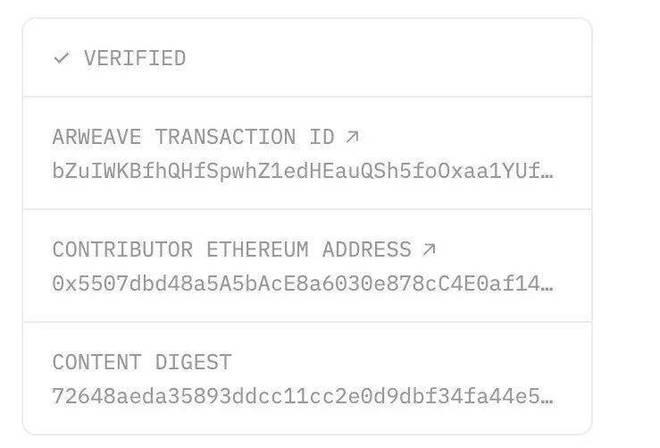
The "stamped" confirmation can be based on content addressing, and the confirmed content will display "Arweave transaction ID," "contributor Ethereum address," and "content summary" at the bottom of the content page.
Moreover, Mirror strictly adheres to the principle of "never storing users' Ethereum private keys directly in the browser" to avoid security and privacy risks.
Since Mirror supports a key and signature-based authorization model, this native authentication method brings additional benefits, such as allowing registration and content recovery without using email.
The backend of Mirror is written in Rust to facilitate future integration of layer two scaling solutions.
"Content Crowdfunding DAO" Empowering Writers with Content Sovereignty
In terms of product form, the Mirror platform is a crowdfunding platform for individual content. Unlike mainstream content publishing platforms, Mirror is a Web 3 native content publishing platform, meaning that from its inception, Mirror has been bound to value attributes, with digital content published on it being tokenized through NFTs and the ownership of individual content being sold to multiple investors through crowdfunding.
It can be said that around each article on Mirror, small decentralized autonomous organizations (DAOs) of stakeholders are formed, where creators, as content producers, are bound to the content through the ENS identity system. When publishing an article, creators must log in with a signature key to obtain writing permissions, publish content, and confirm data; creators earn startup funds through content crowdfunding while retaining a portion of the NFT shares, and investors hold partial ownership of the article through investing in NFTs, with each NFT transfer bringing a certain percentage of profit to all token holders, including the author and NFT holders.
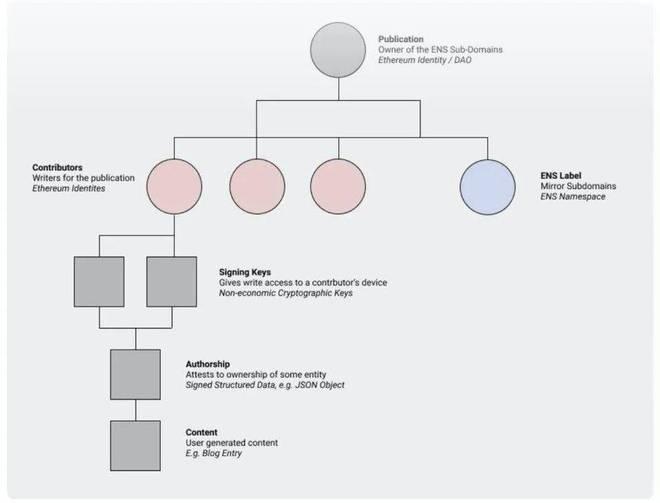
Let’s take the first crowdfunding event initiated on the Mirror platform as an example to see how an actual article crowdfunding operates.
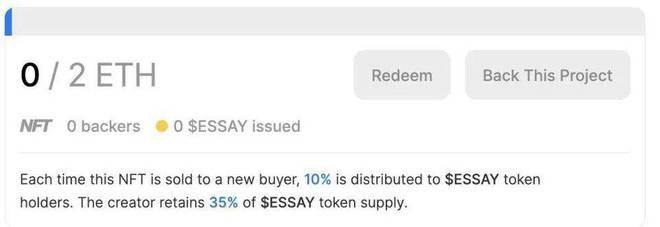
This was a writing crowdfunding activity initiated by John Palmer, a former software engineer and product designer at Snapchat. The crowdfunding started at 12 PM Pacific Standard Time on January 28 (Thursday), with a target amount of 2 ETH tokens. If the fundraising goal is reached, the work will be publicly published for everyone to read and share for free, and the funders will own the work. If the goal is not reached, participants will receive a refund.
The event was overfunded with 9.9865 ETH raised just one hour after its initiation, receiving investments from 63 funders.
The article will mint an NFT representing ownership on the Zora protocol, and funders can send Ethereum to receive ESSAY tokens representing shares of that NFT. ESSAY and other ERC-20 tokens can be freely transferred and redeemed for ETH. Each time the NFT is transferred, the ESSAY token holders can earn 10% of the transaction fee, while John Palmer himself will hold 35% of the total supply of ESSAY tokens.
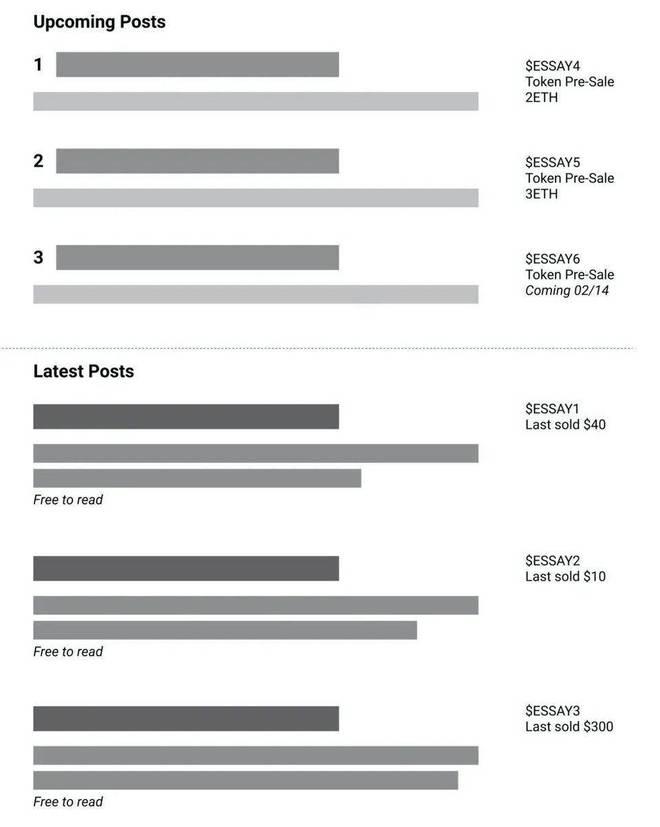
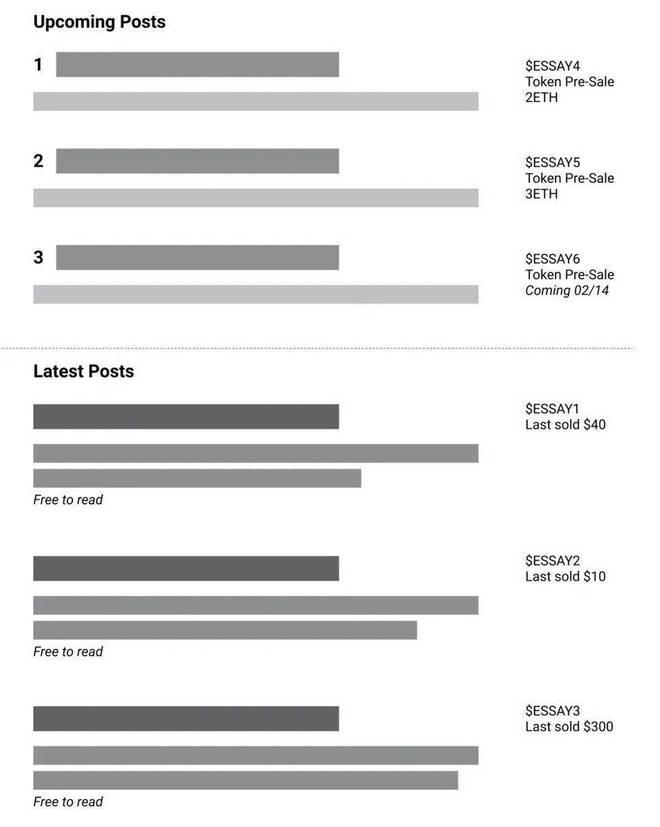
This crowdfunding effect will bring a lot of attention to the author and is more likely to further increase the price of the article content, which is very imaginative.
Content Writing Crowdfunding NFT Ownership Economy
The biggest innovation of Mirror is embracing a brand new ownership economy model, which fundamentally differs from the previous slight adjustments in knowledge payment models, fundamentally changing the structure of content creation.
Fundamentally changing means that content creators no longer have to rely on advertisements and pursue liquidity monetization but can provide high-quality content for specific reader groups, maintaining a self-sufficient possibility. In this ecosystem that introduces the NFT token equity model, a closed loop of production, investment, transfer, and consumption based on content works is formed, thus achieving a self-sufficient writer community economy.
So how does this model operate? How does it enable writers on the platform to potentially earn economic benefits from content output?
The Mirror platform allows content creators to initiate crowdfunding for individual pieces of content, supporting an NFT representing the ownership of that article, where funders can use cryptocurrency to purchase shares of that NFT to support or invest.
It is necessary to first explain the NFT format. NFT stands for Non-Fungible Token, which is the opposite of Fungible, meaning each one is irreplaceable and unique, with each NFT having a unique ID number that can be recognized by smart contracts on the blockchain. This unique property makes NFTs an ideal choice for recording and storing ownership of digital products, including artworks, games, and collectibles. Intellectual property is one of the biggest use cases for NFTs, where NFTs can be used to mark ownership of digital content works, such as images, videos, blogs, music, artworks, etc.
Once content works have a value representation, many benefits arise, allowing numerous participants to join in, achieving value circulation and forming prices.
Thus, NFTs give previously marginal cost-free, infinitely replicable content works scarcity, thereby endowing them with value, allowing them to be freely traded and resold on decentralized trading platforms without permission. This means that writers can now sell NFTs representing ownership of their creative content as unique collectibles or artworks, while the content itself remains an open and freely accessible public good.
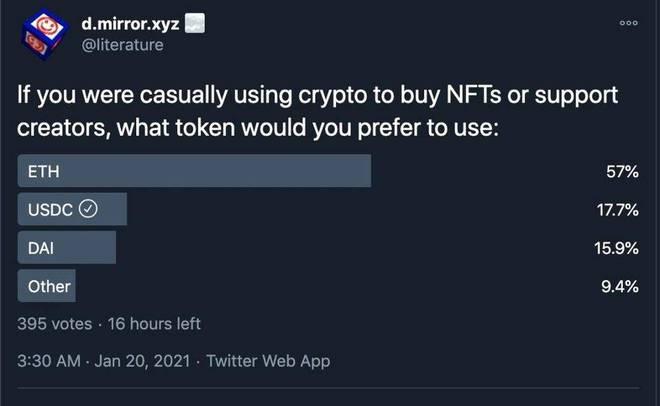
Regarding which cryptocurrency can be used to purchase NFTs, Mirror founder Denis Nazarov initiated a poll on Twitter, which showed that 57% of users support using Ethereum as the payment token.
If a creator wants to invest in long-form writing, it means that there may be no other income sources for a long time, while Mirror provides a platform for writers to initiate fundraising for their upcoming writing plans. After the initiator mints an NFT representing the ownership of that article through a smart contract, it can be opened for investors to purchase using cryptocurrency (ETH or DAI), allowing creators to withdraw the raised funds as startup capital for writing.
For investors, if you happen to be a loyal reader of that writer, you can purchase a share of that NFT to support your favorite author. Since the NFT represents ownership of that work, once the content work succeeds in the future, you can also receive ongoing revenue shares (similar to royalties). Creators can set their own transfer fees, which is the charging ratio for each time the NFT is transferred. Due to the unique identity attributes of NFTs, these fans can also receive an NFT badge certified as a sponsor of that article.
It is important to note that although the ownership of a single content work is limited to one NFT, the ownership of that NFT is fragmented and compatible with ERC20 format contracts, allowing multiple people to jointly own it based on share ratios. Holding a fixed share of the NFT means that the holder can earn transfer fees from the content.

Mirror supports inserting NFT format files into article content, allowing users to directly jump to other NFT platforms and purchase using cryptocurrency.
Of course, if you are not a fan of the author but merely a discerning pure speculator (no offense intended), you can also invest early to purchase NFTs and earn arbitrage profits by reselling NFT shares to redeem the base funds and profits. Since NFTs on Mirror are compatible with ERC20 format, they can be traded on decentralized exchanges like Uniswap, similar to trading options.
Specifically, before starting a content writing project, the steps for creators to initiate crowdfunding include the following two steps:
Step 1: Crowdfunding / Investment before Article Writing Starts
The writer mints an NFT representing the ownership of that article in the crowdfunding contract, after which they can withdraw the raised cryptocurrency (such as Ethereum) to start writing.
Users interested in investing are referred to as contributors, who can send Ethereum to the crowdfunding contract to obtain ownership of that NFT. It is important to note that this NFT can be fragmented and owned by multiple people.
Step 2: Redemption / Withdrawal Steps after Writing Completion
The writer clicks "Accept Auction" to withdraw the Ethereum balance from the crowdfunding contract.
At this point, investors can destroy their held NFT shares to receive an equivalent share of Ethereum profits.
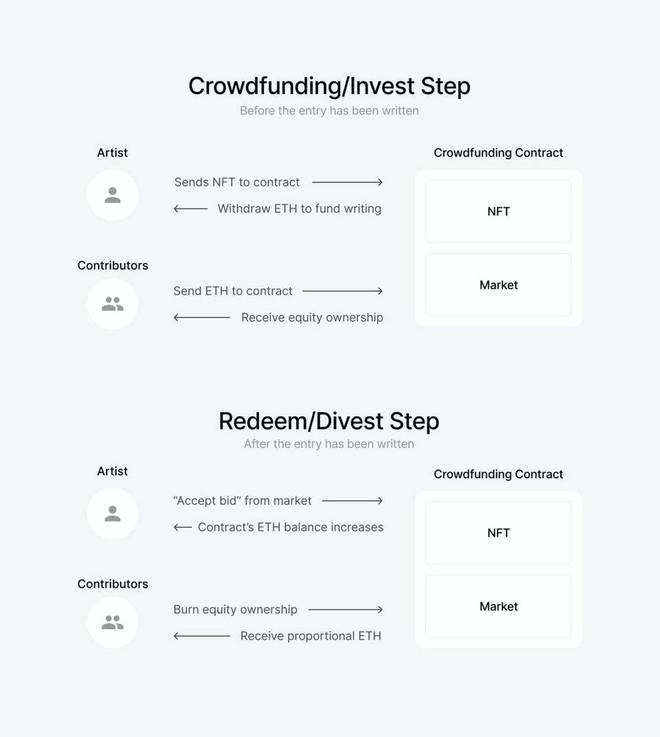
In summary, Mirror is a consumer-grade product that has emerged after a long period of reshuffling in the crypto circle, which not only reveals the potential for crypto products to break out but, more importantly, its core NFT ownership economy model will dismantle the old inefficient production relationships, bringing real value to creators.
Mirror is currently still in the invitation testing phase, but its displayed potential is exciting. Once put into use, it has great potential to empower many writers to sustain their livelihoods through content creation without needing to please advertisers and chase traffic. It is believed that creators from websites like Apple4us will return to the public eye due to a stable organic revenue stream, and more high-quality content websites will emerge—this is the best posture to revolutionize today's internet.
References:
https://www.chinaventure.com.cn/cmsmodel/news/detail/310038.html
https://www.chainnews.com/articles/767407855704.htm
https://apple4us.com/2018/apple4us-feng-yin-f45fd0f1
https://dev.mirror.xyz/J1RD6UQQbdmpCoXvWnuGIfe7WmrbVRdff5EqegO1RjI
https://dev.mirror.xyz/llJAboiDJwBZAFz-CXU7fL2p8v5Wz6MjfluLafewQ
https://www.chainnews.com/articles/005725590108.htm
https://www.zhihu.com/question/20057591/answer/33421166



